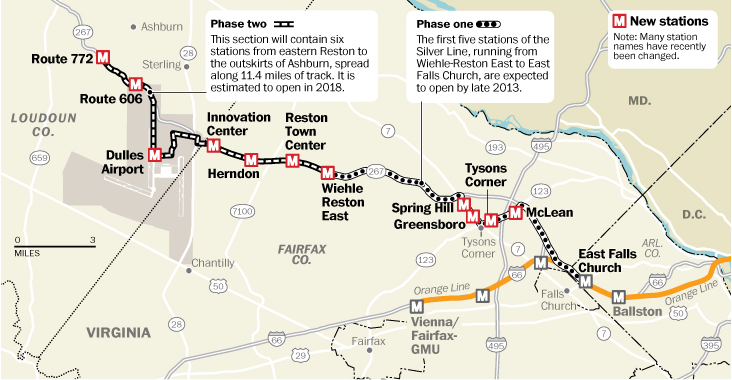by James A. Bacon
The final obstacle to construction of Phase 2 of the Rail-to-Dulles project fell yesterday when the Loudoun County Board of Supervisors voted to fund its estimated $270 million share of the project. Now all four funding partners — Loudoun, Fairfax County, the commonwealth of Virginia and the Metropolitan Washington Airports Authority (MWAA) — have affirmed their participation in a plan brokered last year to complete the METRO extension.
The last remaining question is how much the project will cost. Will the winning bid exceed the estimated $2.8 billion price tag, in which case overruns will be charged to the tab of Dulles Toll Road users in the form of higher tolls? Or will the low bid fall under the benchmark, thus providing relief for toll road users? An earlier decision by the MWAA board to scrap preferences for union Project Labor Agreements will encourage open-shop companies to submit bids, thus improving the odds of a favorable outcome.
The Rail-to-Dulles project is both a necessity for Northern Virginia and an abomination. On the positive side, the Silver Line will help integrate Tysons Corner and the Dulles Corridor with the region’s urban core. Rail service will trigger re-development of disconnected, low-density human settlement patterns into walkable, mixed use communities around 11 METRO stations. Coupled with services such as ZipCar, Uber and Avego and others yet undreamed of, the Silver Line will liberate thousands of Northern Virginians from their automobile-dependent lifestyles.
However, the political process of allocating costs for constructing the rail line was an orgy of rent-seeking and cost shifting. Like so many other transportation projects, rail and highway alike, there is no pretense that those who use and benefit from the $6 billion Rail-to-Dulles project will pay for it. The financing of Phase 2 is particularly egregious, diverting hundreds of millions of dollars from commuters on the Dulles Toll Road. DTR commuters could well wind up paying more per trip to support the Silver Line than Silver Line passengers will pay in fares.
Meanwhile, land owners fortunate enough (or canny enough) to have property located near METRO stations will make a double killing. First, their land will gain value thanks to proximity to the stations. Second, Fairfax County and Loudoun Counties will reward them with increased density. Fairfax landowners will pay a small share of the $6 billion tab through a special tax district. Remarkably, landowners on top of METRO stations will pay at the same rate as landowners a half mile away, even though they enjoy the lion’s share of the benefit. (Loudoun supervisors are considering a special tax district for Phase 2 but have not approved it.) Thus, the project can be seen as a massive redistribution scheme in which politically connected winners use their clout to extract wealth from the politically powerless.
Meanwhile, it’s not at all clear that the $6 billion investment will do anything to relieve regional congestion. While the rail line will take some commuters off Northern Virginia roads, high tolls could drive other commuters off the Dulles Toll Road onto secondary roads, making driving conditions on them all the more unbearable. Second, Fairfax County has approved so much added density to Tysons Corner — creating far more traffic at full build-out than the METRO can handle — that someone will have to find another $4-5 billion to upgrade road and highway access to the business district.
While individual winners and losers can be clearly identified, the dynamics are so complex that it is impossible to say whether Rail-to-Dulles will be a net gain or loss for Northern Virginia as a whole. Not only is the answer unknowable now, it may well be unknowable 2o years from now. The results will be too diffuse and too complex to disentangle. It would be nice to think that we’ve learned some lessons from the years-long controversy, but I’m not confident that we’ve learned anything at all. People will continue believing whatever the hell they want to believe.



